The Imperial Treasury of Vienna stands as a profound symbol of the grandeur and historical depth of European royalty. Nestled within the regal confines of the Hofburg Palace, this treasury holds an exquisite collection of artifacts that span centuries, each piece telling a unique story of power, devotion, and artistry.
Note: This article contains affiliate links. In case you purchase something through one of these links, we may receive a small commission at no extra cost for you. Thank you for helping us keep creating the free content on this website!
The Imperial Treasury, or Schatzkammer, is not just a room filled with relics; it is a gateway to the past, offering us a tangible link to the lives and times of the empires that once shaped our world. Here lies the essence of European history, encapsulated within jewels, crowns, and sacred relics.
The Significance of the Imperial Treasury in European History
From the crowns of Holy Roman Emperors to the intricate vestments worn during key historical ceremonies, the treasury serves as a custodian of Europe's rich and complex history. These artifacts are not merely beautiful objects; they are symbols of the cultural and political legacies that have influenced contemporary Europe.
Overview of the Treasury's Collection
The Imperial Treasury holds a collection that is nothing short of breathtaking, a treasure trove of history and grandeur spanning centuries. Within its sacred halls, one finds not merely artifacts but embodiments of power and faith. Among the many jewels of this collection, the regal regalia stand out, including the ornate robes of the Order of the Golden Fleece, each thread woven with the aspirations and achievements of monarchs past. These pieces are not just garments but symbols of sovereignty, draped in the weight of dynastic legacies.
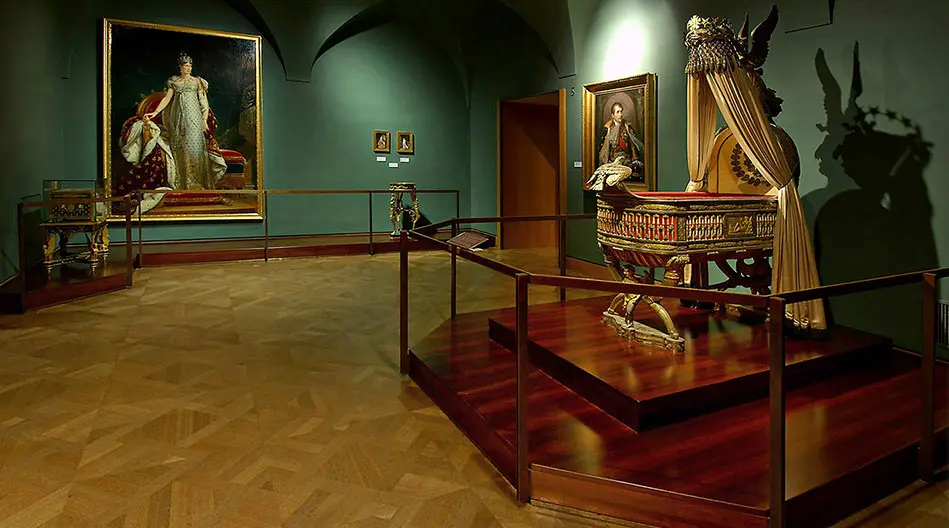
Equally compelling are the ecclesiastical relics that form an integral part of the Imperial Treasury's storied holdings. These sacred items, ranging from saintly relics to lavishly adorned altarpieces, narrate tales of divine intervention and human devotion. They evoke a profound sense of reverence and awe, serving as a bridge between the celestial and the earthly, between the divine and the devout.
The opulent ornaments scattered throughout the collection—be it the legendary Ainkhürn, believed to be a unicorn horn, or the exquisite imperial crowns—each carry with them stories that border on the mythical. The Ainkhürn, for instance, encapsulates the blend of belief and wonder that characterized the medieval mind, a symbol of purity and rarity cherished not only for its supposed magical properties but also for its representation of the unattainable and the mystical.
Every piece in the Imperial Treasury is a narrative frozen in time, a testament to the incredible human penchant for beauty and symbolism. Walking through the Treasury is like wandering through the pages of a richly illustrated manuscript, where every turn reveals another chapter of our collective past, imbued with the aura of legend and the patina of time.
The Crown Jewels and Imperial Regalia in the Imperial Treasury
These symbols of monarchical authority are not just artifacts; they are profound emblems of a divine right that claims descent from the heavens themselves. Each gemstone, each metal band, each orb, and scepter carries the weight of history, binding the temporal authority to the celestial.
In the quiet, solemn corners of the Imperial Treasury, the regalia whisper tales of battles fought, of alliances forged, and of nations shaped under the watchful eyes of sovereign rulers. The crowns, imbued with the hopes and fears of their bearers, shimmer with a potent energy. They are not just adornments for the head; they are mandates of power, commanding respect and reverence.
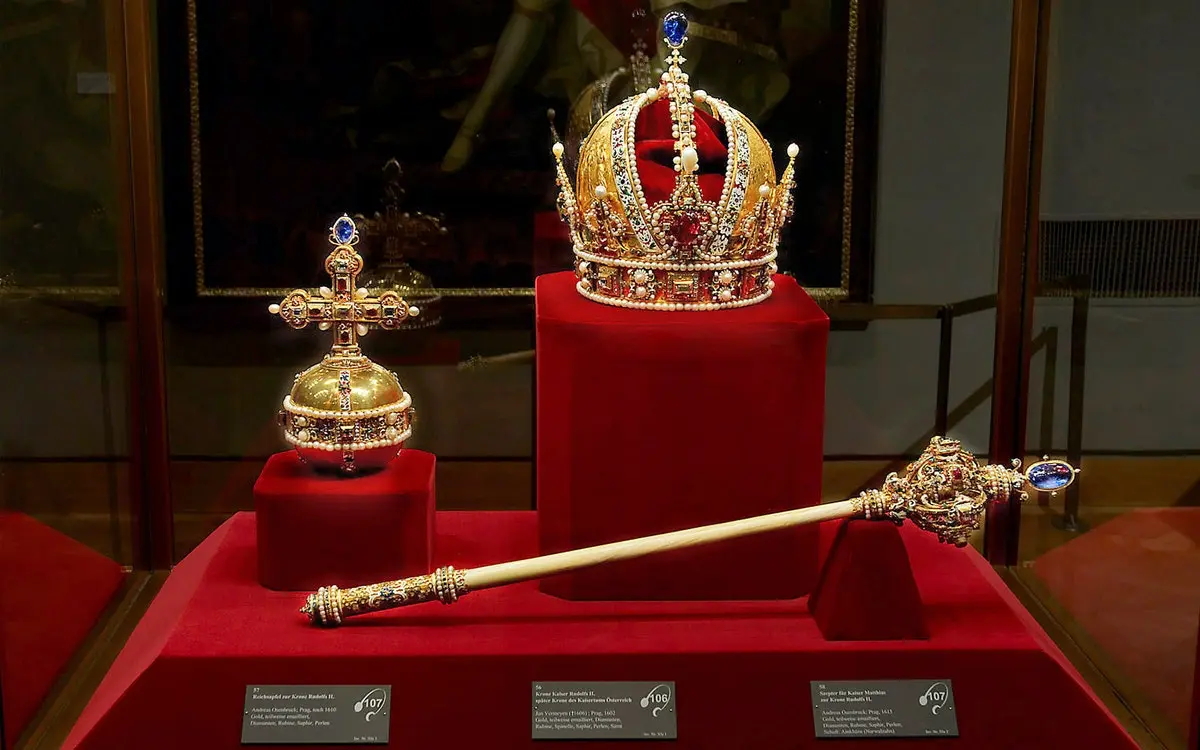
To stand in the presence of such treasures is to feel the pulse of history through the veins of the present. The Imperial Treasury serves as a bridge between the past and the future, its contents a series of promises carved in gold and set with stones that have seen the rise and fall of empires. Here, at the confluence of divine right and earthly authority, the crown jewels and the Imperial regalia stand as enduring testaments to the complex, often mystical, relationship between a sovereign and their domain.
The Imperial Treasury Vienna is over 650 years old, established in the 14th century.
The Holy Roman Empire Crown in the Imperial Treasury
The crown of the Holy Roman Empire, resplendent with its jewels and gold, stands as a paramount icon within the Imperial Treasury. This magnificent crown was not merely a ceremonial adornment but a potent symbol of divine right and kingly dominion. As it rested upon the heads of emperors, it was a visible sign of celestial approval, intertwining the divine with the earthly rule. Each gem and each golden flourish was a testament to the empire's grandeur and the emperor's supreme role as a chosen leader under God’s expansive canopy.
Within the hallowed halls of the Imperial Treasury, the crown gleams as a beacon of historical legacy and spiritual profundity. It draws countless visitors who gaze upon it, not just as a piece of regal attire, but as a relic that has witnessed the ebb and flow of European history. Its presence evokes a deep emotional response: a mixture of awe and reverence, a palpable connection to those who once wore it. The crown is not just an artifact; it is a symbol of the lofty ideals and heavy burdens of leadership, a perpetual reminder of a ruler’s duty to both his kingdom and his faith.
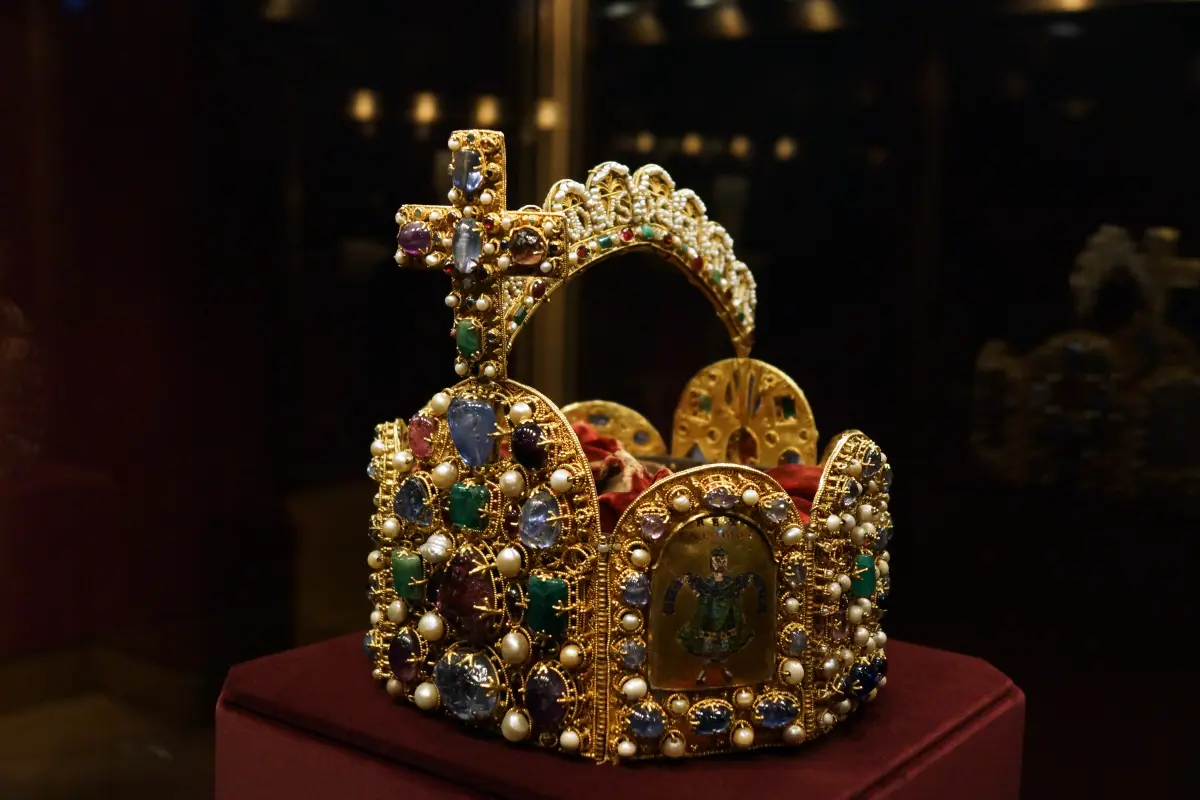
Thus, the crown of the Holy Roman Empire, cherished and preserved within the Imperial Treasury, continues to echo the ancient resonances of power and piety. It invites us to reflect on the past with a sense of wonder and solemnity, reminding us of the timeless human quest for guidance and governance under the gaze of the divine. The crown remains a profound declaration of authority, a jewel in the crown of history itself, ever brilliant and ever daunting.
Other Notable Pieces in the Imperial Regalia
Each piece, from the regal crown to the formidable Holy Lance, carries the weight of history and the aura of divine right, passed down through generations of monarchs. These are not merely objects but pivotal characters in the storied pageantry of monarchy, their very presence at coronations and state functions serving as a bridge between the past and the present.
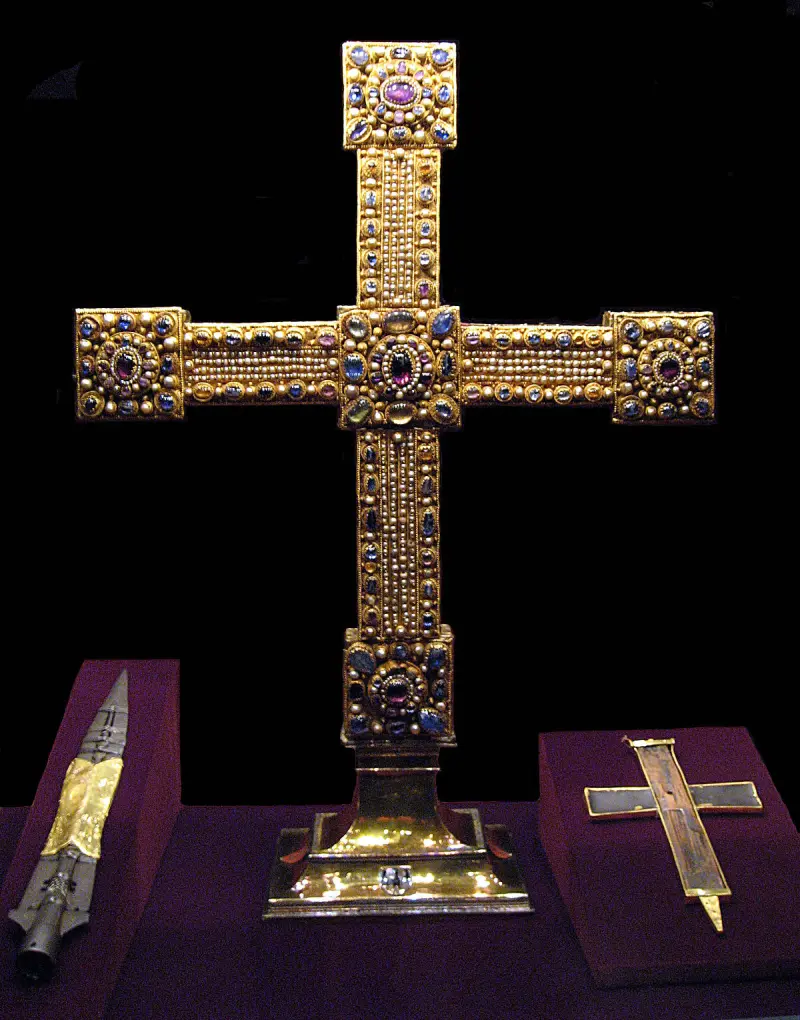
In the grand tapestry of the Imperial Treasury, the scepter and orb shine with particular brilliance. The scepter, a rod of authority, is as much a staff of power as it is a baton of responsibility, bestowed upon those deemed worthy of leading. The orb, a celestial sphere cradled in the arms of rulers, symbolizes the earthly realm touched by the heavens—its presence a solemn reminder of a monarch's duty to both their country and the greater cosmos. These symbols, steeped in ancient tradition, imbue each ceremonial occasion with a profound sense of sacred duty and continuity.
The Holy Lance, also a part of this esteemed collection within the Imperial Treasury, holds its own unique allure. Legend and lore cloak this artifact, said to possess the power to bestow victory and divine favor upon its bearer. The very essence of these regalia pieces, including the lance, casts an atmosphere of timeless dignity and awe during state functions, reminding all of the enduring legacy and the solemn commitments of those who wield them. Through the Imperial Regalia, history does not merely echo; it resonates with the heartbeat of a nation.
Ecclesiastical Treasures in Imperial Treasury
The ecclesiastical treasures of the treasury reflect the profound spiritual and religious dimensions of royal authority. These items, ranging from reliquaries to vestments, highlight the intertwining of church and state throughout European history.
The Burgundian Inheritance
The Burgundian Inheritance housed within the Imperial Treasury is not merely a collection of objects but a profound narrative woven from the threads of European history. Each piece, whether it be sumptuous fabrics, dazzling precious stones, or intricate works of gold, carries the weight of the past, echoing the grandeur and the strategic marriages and alliances that expanded the reach of the Habsburg dynasty. These artifacts, curated meticulously in the Imperial Treasury, serve as a testament to the power and prestige that burgeoned through these unions, enveloping viewers in the rich tapestry of historical intrigue and royal ambition.

The contents of the Burgundian inheritance are evocative of a time when art and diplomacy intertwined, with each item in the Imperial Treasury telling a story of conquests not just of lands, but of hearts and minds across Europe. The vibrant colors of the fabrics and the sparkle of the gems reflect the allure and opulence that the Burgundian Dukes wielded to forge bonds and assert their influence. As one gazes upon these treasures, it is easy to be transported back to the candle-lit halls of power where the fate of nations was often decided over a piece of embroidered silk or a finely cut diamond.
Indeed, the Imperial Treasury, through the prism of the Burgundian inheritance, invites one to ponder the profound impact of these historical artifacts beyond their aesthetic value. They encapsulate a period of cultural and political ferment, highlighting how beauty and craftsmanship were employed as tools in the grand chess game of European power politics. This inheritance does not just enrich the treasury; it enriches our understanding of the human desire to create and control, to connect and conquer, making the Imperial Treasury a repository of not only material wealth but also of the enduring human spirit.
Relics and Liturgical Items in the Imperial Treasury
Among its revered collections are relics and liturgical items that are not only artifacts of deep religious significance but also narrators of the spiritual journey of countless believers. Each piece, from the fragments of the True Cross to the intricately adorned gospel books, carries with it a celestial story that echoes through the halls of the treasury.
In the quiet corners of the Imperial Treasury, one can find the tangible touchstones of faith that have shaped the spiritual landscape over millennia. These items have been integral to sacred rituals and ceremonies, enveloping the space in an aura of divine presence. The fragments of the True Cross, for example, are more than just ancient wood; they are remnants of the pivotal moment in Christian faith, revered and preserved with utmost care.
Further enriching the treasury's divine collection are the elaborately decorated gospel books. These books are not merely written texts but are works of art, adorned with precious metals and stones, each page a testament to the fervor and reverence of those who created and used them in worship. The presence of these sacred items within the walls of the Imperial Treasury invites all who enter to connect with a past that continues to inspire faith and devotion in the present.
Secular Treasures and Their Stories
Within the hallowed halls of the Imperial Treasury, secular treasures hold court, each with its own narrative that whispers through the corridors of time. These artifacts are not just remnants; they are the vibrant chronicles of earthly endeavors, carrying with them the weight of political machinations and the personal triumphs and tragedies of emperors who once held the world in their grasp. In these halls, the glittering jewels and ornate scepters are not mere objects, but symbols of power and ambition, poignant reminders of the temporal realm shaped by human hands and wills.
The Imperial Treasury, a repository of grandeur, does not merely safeguard relics; it preserves the stories of those who shaped history. Every gem-set sword, every golden crown, and every engraved coin tells a tale of conquests, dreams, and despairs. These are the tales that contrast sharply with the spiritual narratives of ecclesiastical treasures, which speak of divine guidance and celestial quests. Here, the secular artifacts narrate a different kind of saga—one of strategic alliances, brutal skirmishes, and the often-lonely burden of leadership.
As visitors tread softly past these displays, they can almost hear the echoes of imperial decrees and the silent sobs of rulers who lost as much as they gained. The emotional resonance of these objects invites us to ponder the complex legacies of those who once ruled the earth, making the Imperial Treasury not just a place of historical interest, but a profound teacher of life's impermanent and intricate tapestry.
The Cradle of the King of Rome
This exquisite artifact, more than just a piece of furniture, encapsulates the ambitions and dreams of an era defined by its colossal aspirations and dramatic downfalls. The cradle, once rocked by the hopes of an empire, is lavishly adorned with intricate symbols and heraldic emblems that whisper stories of glory and melancholy intertwined.
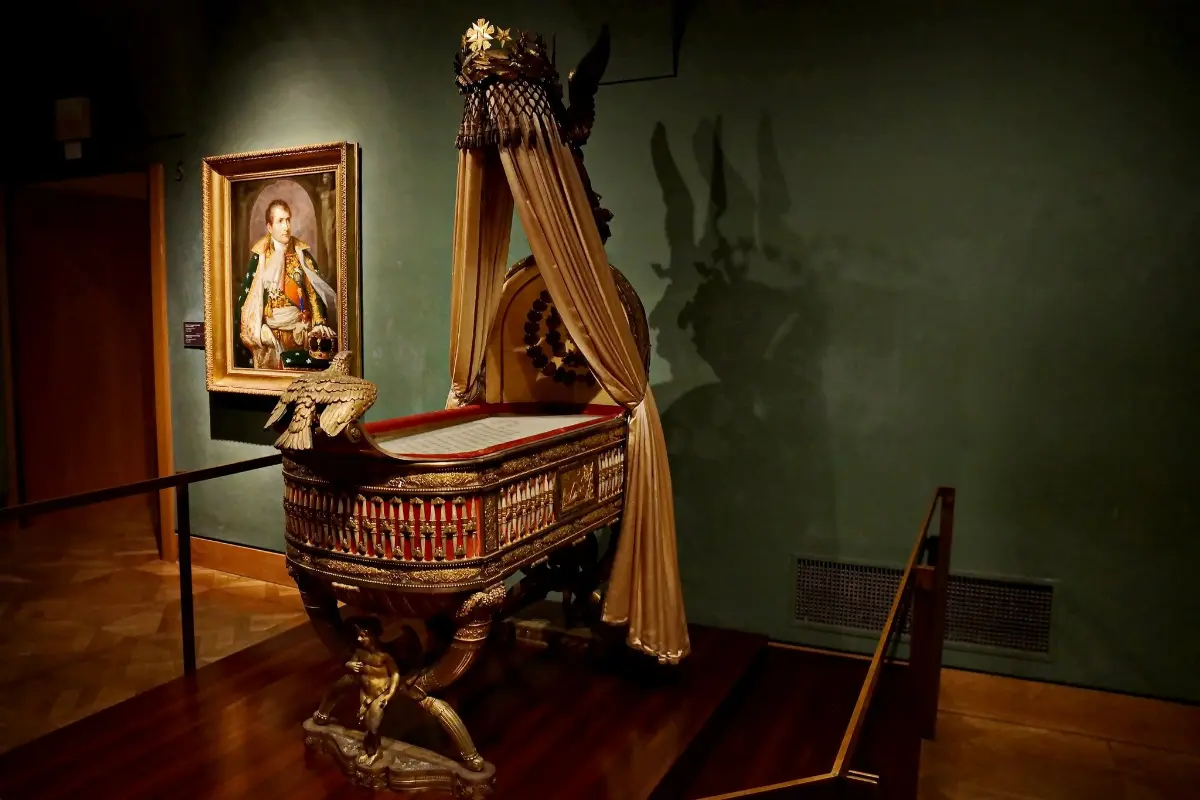
This poignant cradle was not merely a resting place for Napoleon’s son but a statement of imperial continuity and grandeur. Housed in the Imperial Treasury, it is surrounded by other artifacts that each carry their own weight of historical significance, but none quite echo the same poignant mix of hope and sorrow as the cradle of the King of Rome. The delicate carvings and gold leaf that embellish its surface reflect a time when Europe lay at Napoleon's feet, and yet, they also foretell the transient nature of power.
Visitors to the Imperial Treasury are often drawn to this cradle, not just for its artistic merit but for the human story it represents. In its stillness, one can almost hear the echoes of a lullaby meant to soothe a child destined never to wield the power his birthright promised. It stands as a reminder of what could have been—a symbol of potential unfulfilled and the inevitable passage of time that spares no empire, no matter how grand.
The Saber of Charlemagne
In the heart of medieval lore, the saber of Charlemagne stands as a symbol of power and divine kingship, deeply woven into the fabric of European history. This legendary weapon, said to have been wielded by Charlemagne himself, is more than just a piece of metal; it is a relic of the time when Europe was being forged by blood and iron under the rule of its most formidable monarchs.
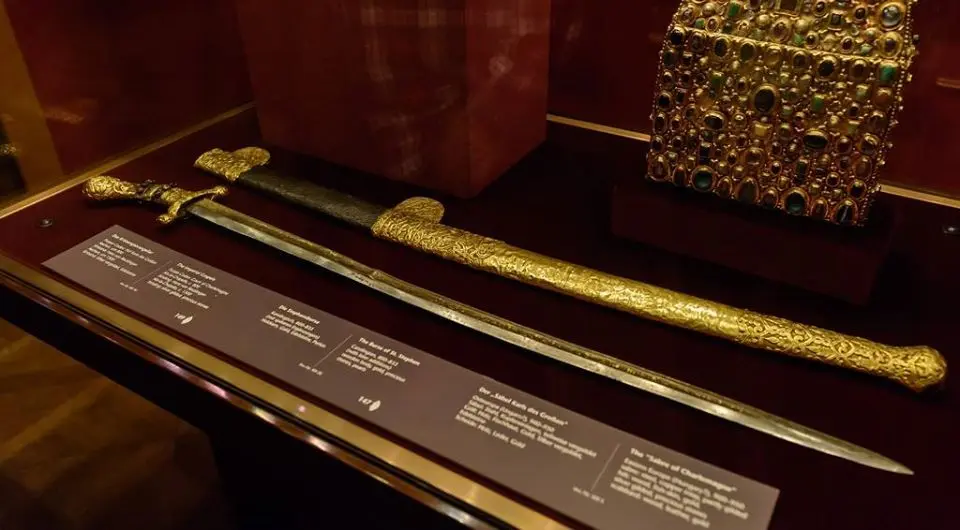
The artifact is commonly referred to as the Sabre of Charlemagne, who lived from 742 to 814. This impressive weapon measures a total length of 90.5 cm, with a blade length of 75.8 cm and a width of 2.8 cm. It is believed to be an early type of Hungarian (Magyar) saber, likely crafted in the early 10th century or earlier. The saber forms a part of the Aachen regalia associated with the Holy Roman Empire. According to historical tradition, the sabre was rediscovered by Otto III when he exhumed Charlemagne's tomb in the year AD 1000. This piece not only serves as a significant historical artifact but also as a testament to the rich martial traditions and regal ceremonies of medieval Europe.
The saber, reputed to have been housed in the Imperial Treasury, embodies the spirit and the authority of Charlemagne's empire, which stretched across vast territories that comprise much of modern-day Europe.
The allure of the saber extends beyond its physical form, capturing the imagination of those who hear its tales. It is not just an artifact; it is a testament to the enduring legacy of Charlemagne, often remembered as the "Father of Europe." His campaigns not only expanded territories but also laid the groundwork for the cultural and political landscape of the continent. It is in the Imperial Treasury that the saber finds its sanctity, preserved amidst other regal artifacts, each narrating their own stories of historical conquests and royal endeavors.
As the saber rests within the silent walls of the Imperial Treasury, it beckons to those who value history and legend intertwined. The very thought of Charlemagne’s saber ignites a sense of awe and reverence—a reminder of a past where rulers were seen as the chosen of God, and their weapons, the instruments of divine will.
Each glance at the saber in the Imperial Treasury is a journey back in time, a bridge to an era of knights, emperors, and battles that shaped the world as we know it today. The saber of Charlemagne is not merely a relic; it is a beacon of the medieval spirit, enduring through centuries as a symbol of imperial might and legacy.
The Gem Collection
The treasury’s gem collection is nothing short of miraculous, featuring gems of breathtaking beauty and fascinating lore. These gems not only served as ornaments but also as talismans and symbols of power.
The Legendary Ainkhürn (Unicorn Horn)
In the hallowed halls of history, the Ainkhürn, or unicorn horn, occupies a revered place, especially within the storied walls of the Imperial Treasury. This enigmatic artifact, heralded throughout the ages for its mystical allure and legendary origins, was not, as many believed, the spiraled horn of a mythical unicorn but rather the tusk of a narwhal. Yet, its true nature did little to diminish its value; if anything, it only enhanced the aura of mystery that surrounded it.
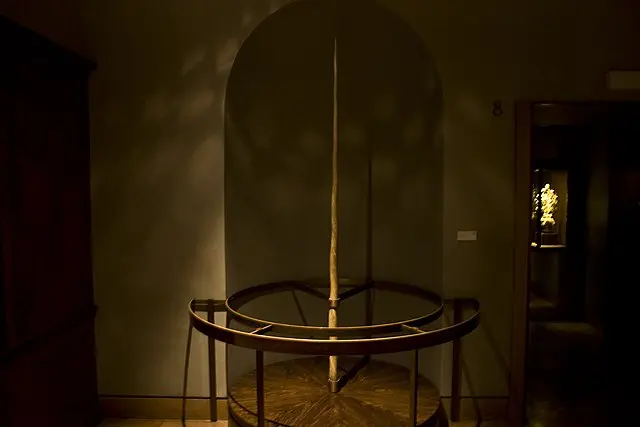
The Imperial Treasury once held this prized possession aloft, a symbol of divine right and supreme power, believed to possess the ability to purify water, cure ailments, and even detect poisons. Its rarity made it as valuable as the jewels and gold that shared its space. Lords and ladies, knights and scholars, all revered the Ainkhürn, not just as a relic of natural history but as a conduit of unexplained, magical forces.
As the centuries passed, the legend of the Ainkhürn within the Imperial Treasury grew ever more intertwined with the narrative of the realms it graced. It stood as a testament to mankind's ceaseless quest for the miraculous, a beacon of the eternal human yearning to touch the divine. The allure of the Ainkhürn reminds us that sometimes, the greatest mysteries of the past were hidden in plain sight, masquerading as mere curiosities in the echoing chambers of grand palaces.
Notable Gemstones and Their Lore
In the glittering world of gemstones, there are treasures that do more than dazzle the eye—they whisper stories of the past, echoing through halls of power and mystery. Among these, the Sancy Diamond shines with a dark allure, cloaked in tales of misfortune and intrigue that trace back to the kings and queens who once coveted its unique, pale yellow sheen. It is said that this gem's journey through the hands of nobility is marked by a trail of ill fate, making it a notorious highlight in the Imperial Treasury's collection.
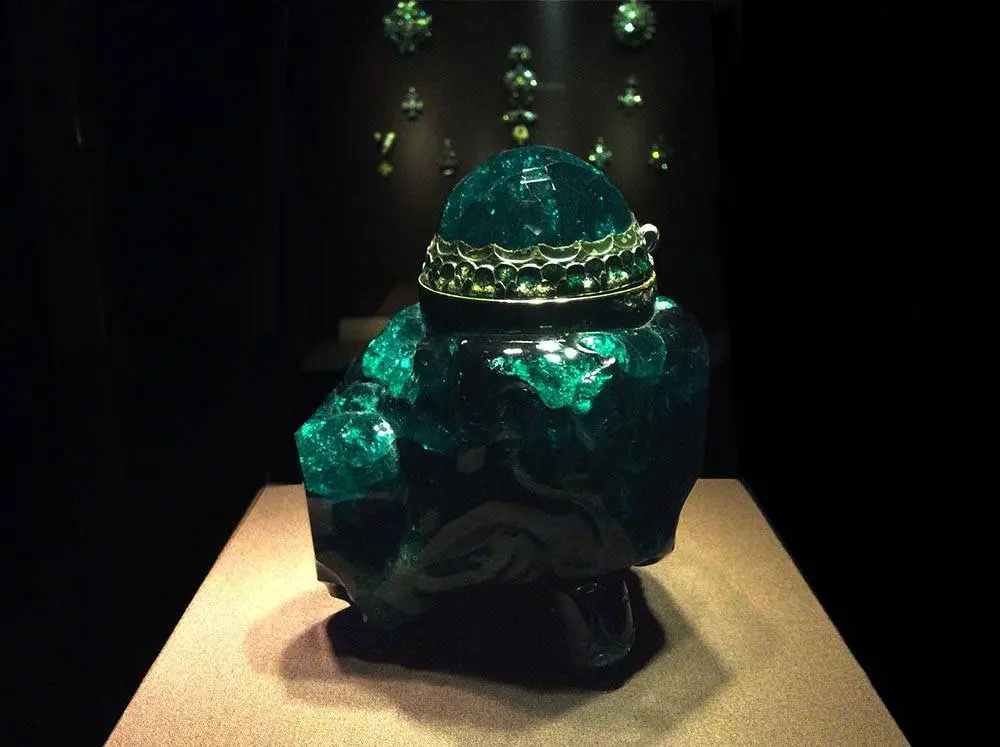
Another jewel that commands attention with its historical gravity is the Florentine Diamond. With its lost origins shrouded in the mists of time, it emerged as a symbol of the Habsburg’s extensive influence, spanning continents with its imposing size and the fiery brilliance of its facets. The Florentine Diamond, once a centerpiece in the Imperial Treasury, narrates a saga of power, theft, and the eventual disappearance, leaving behind a legacy that continues to fascinate historians and gem lovers alike.
These storied jewels, held within the secure walls of the Imperial Treasury, serve as portals to bygone eras, offering a glimpse into the opulent lives and tumultuous reigns of their former owners. Each gem, with its unique lore, forms an irreplaceable thread in the fabric of history, weaving tales of glory, conspiracy, and the eternal human fascination with beauty and power.
The Vestments and Robes
The collection of vestments and robes in the treasury paints a vivid picture of the ceremonial splendor of the European courts. These garments, each crafted with incredible skill and care, were worn on occasions that shaped the history of the continent.
Coronation Robes and Their Significance
The coronation robes are much more than mere ceremonial attire; they are woven narratives of power, duty, and the undying echos of sovereignty that resonate through the halls of the Imperial Treasury. Each robe, meticulously crafted from the richest of fabrics and adorned with the most intricate of embroideries, serves as a testament to the profound occasion of a monarch's coronation. They are preserved and revered within the sacred confines of the Imperial Treasury, a place where the legacies of rulers are enshrined in threads of gold and silver.
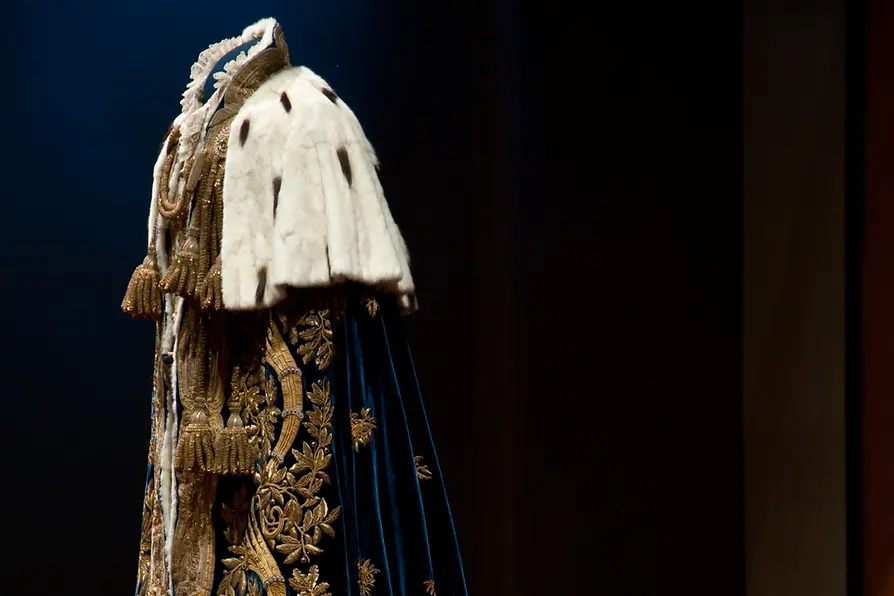
The significance of these robes extends beyond their breathtaking beauty and into the very essence of what they represent—the continuity of governance and the solemn responsibilities bestowed upon those who wear them. As each monarch steps into their robes, they step into a role shaped by centuries of tradition. These garments tell stories of past ceremonies, each unique with its own set of challenges and triumphs, yet all bound by the common thread of leadership and duty.
To gaze upon these robes within the Imperial Treasury is to feel the weight of history. They are not just relics; they are symbols of the promise each ruler makes to guide their nation with wisdom and integrity. The Imperial Treasury thus serves not merely as a repository of regalia but as a vibrant, living archive of the solemn vows made by those called to the highest echelons of power. These coronation robes remind us that leadership is both a privilege and a profound responsibility, each stitch a reminder of the enduring spirit of governance that each monarch pledges to uphold.
The Robes of the Order of the Golden Fleece
The robes of the Order of the Golden Fleece are steeped in the rich, vibrant history of a bygone era, when knights upheld the values of chivalry and honor. Founded in the 15th century, this order of chivalry not only symbolizes the noble pursuits of its members but also embodies a deep connection to the romantic spirit of medieval Europe. The robes themselves are magnificent, woven from the finest materials, each thread holding stories of gallant knights and their noble deeds. These garments are often displayed in the revered halls of the Imperial Treasury, where they shimmer under the soft glow of the ancient lights, whispering tales of yore to those who walk their hallowed grounds.
More than just ornamental, these robes serve as a bridge between the past and the present, carrying the weight of historical significance. Each fold and crease is a testament to the enduring legacy of the knights who once wore them. The Imperial Treasury, home to these precious artifacts, serves as a sanctuary where the values of the Order are preserved and celebrated. In this sacred space, the robes are not merely relics; they are enduring symbols of the ideals that shaped an era.
As we behold these robes today, displayed with reverence in the Imperial Treasury, we are reminded of the timeless virtues of bravery, loyalty, and honor. They beckon us to remember a time when chivalry was the fabric of daily life, inspiring us to carry forward the noble legacy of the knights of the Order of the Golden Fleece into our modern world. Their beauty and significance resonate deeply, echoing the ancient call of chivalric culture that still captivates the hearts of those who value history and heritage.
The Influence of the Habsburg Dynasty
The Habsburg dynasty, a name etched deeply in the annals of European history, wielded a profound influence that continues to echo through time. As one traverses the vaulted halls of the Imperial Treasury, the air is thick with the weight of centuries, each artifact a whisper from the past, telling tales of power, conquest, and the intricate dance of diplomacy. The Imperial Treasury stands not only as a repository of opulence but also as a testament to the Habsburgs' complex legacy, showcasing the vast empire and the myriad cultures under its sway.

With every jewel-encrusted sword and ornately decorated goblet, the Imperial Treasury reveals the Habsburgs' calculated mastery of art as a tool for dominion. These pieces, collected from the far reaches of their realm, speak to a strategy of cultural amalgamation and control, an empire built as much on the beauty of diversity as on the might of swords. The artifacts are imbued with the essence of an era where art and power were interwoven, each piece a node in the vast network of Habsburg influence.
The emotional resonance of the Imperial Treasury is palpable, a vivid tableau of ambition and grandeur. It invites one to reflect on the sweeping impact of the Habsburg dynasty, an influence that shaped nations, cultures, and histories. The treasury serves not just as a collection of treasures, but as a profound reminder of how the echoes of a powerful dynasty can resonate through the ages, still felt in the cultural and political landscapes of Europe today. As one stands amidst the Habsburg legacies preserved within these walls, it becomes clear that the Imperial Treasury is much more than a mere collection; it is a poignant chronicle of a dynasty's enduring mark on the world.
How the Habsburgs Shaped the Treasury
The Habsburgs, a dynasty synonymous with grandeur and cultural patronage, left an indelible mark on the very soul of the Imperial Treasury. They were not merely collectors of ephemeral treasures; they were architects of a legacy that blended the opulence of their reign with an enduring respect for the arts. As they commissioned countless artifacts, the Imperial Treasury became a repository not only of wealth but also of the artistic fervor that swept through their era.
This period was a renaissance of aesthetic appreciation, where each piece curated or commissioned by the Habsburgs was infused with deep cultural significance. The Imperial Treasury grew under their watchful eyes into a sanctum of splendor, housing relics that whispered tales of power, devotion, and artistic innovation. Their profound impact on the treasury is a testament to their vision of preserving not just power, but the beauty that power could create.
The artifacts that now rest within the walls of the Imperial Treasury serve as a mosaic of history, each piece a brushstroke in the vast canvas of the Habsburg dynasty's legacy. It was their foresight and dedication to the arts that crafted a treasury rich not only in material wealth but in cultural treasures that continue to captivate and inspire. Through their efforts, the Habsburgs did not just shape a collection; they shaped history itself, leaving behind a treasure trove that embodies the zenith of their cultural and artistic achievements.
Habsburg Heirlooms and Family Legacy
The Habsburg dynasty, with its rich tapestry of political marriages, strategic alliances, and centuries of rule, has left behind a collection of heirlooms that do more than sparkle behind glass—they whisper the secrets of a formidable European legacy. The Imperial Treasury, safeguarded within Vienna's Hofburg Palace, serves not just as a repository of opulence but as a silent narrator of Europe's intricate past. Each jewel, each insignia, each piece of regalia carries the weight of history, embodying the glory and the burden of imperial responsibility.

These heirlooms, preserved in the Imperial Treasury, are far from mere antiquities; they are the enduring symbols of a family that wove their lineage through the very fabric of European history. The Habsburgs were not just rulers; they were architects of a political landscape that defined the continent. The artefacts and relics that fill the treasury rooms are imbued with stories of alliances that were as often forged in marriage halls as they were on battlefields. From the delicate beauty of a queen's necklace to the stern iron of a king's sword, each item is a chapter in a saga of power, betrayal, and ambition.
The emotional resonance of the Habsburg heirlooms extends beyond their material value. To wander through the corridors of the Imperial Treasury is to walk alongside ghosts of emperors and empresses who once held Europe in the palm of their hand. It is a poignant reminder of the transient nature of power, how it shifts, evolves, and ultimately fades, leaving behind only these precious tokens for posterity. As heirs to this profound legacy, we are left to reflect on the intertwining of family and politics, the personal sacrifices for power, and the indelible marks they leave on the sands of time.
Artifacts from Across the Empire
The artifacts in the treasury come from various parts of the vast Habsburg Empire, each contributing to a richer understanding of the empire’s complexity and cultural diversity.
Contributions from Different Regions
The Imperial Treasury holds not just jewels and gold but stories—vivid tales spun from the very fabric of the Habsburg Empire. Every artifact, from the intricate Hungarian coronation robe to the Bohemian crystal vase, carries whispers of the past, each echoing the unique voice of its origin. These items are more than mere objects; they are emblems of regional pride and craftsmanship, lovingly preserved under the umbrella of imperial rule.
Within the vast collection of the Imperial Treasury, each piece from the different regions of the empire speaks to a local heritage that flourished even in the shadow of a dominating central power. The Hungarian coronation robe, with its detailed embroidery and rich fabrics, not only symbolizes the grandeur of ceremonies past but also the meticulous skill of Hungarian artisans who crafted beauty as a testament to their cultural identity. Similarly, the Bohemian crystal vase, with its flawless clarity and delicate cuts, stands as a beacon of Bohemian tradition—its brilliance a proud declaration of local mastery celebrated throughout the empire.
These regional contributions, so poignantly safeguarded in the Imperial Treasury, weave a colorful tapestry of Habsburg history. They narrate a story of diversity within unity, where each region's distinct cultural signature is both preserved and cherished. In the grand halls of the treasury, every artifact pulses with the life of its creators, their aspirations and their enduring pride, all encapsulated in the legacy of imperial splendor. The stories these objects tell are indispensable, for they allow us to glimpse the rich mosaic of human endeavor that thrived in every corner of the Habsburg realm.
The Cultural Significance of These Contributions
The Habsburg dynasty, with its sprawling empire that crossed borders and blended cultures, left an indelible mark on the world through the awe-inspiring artifacts housed in the Imperial Treasury. Within its venerable walls lie treasures that are not simply objects of opulence; they are profound testimonies to a complex history of cultural exchange and mutual influence. These contributions to the Imperial Treasury reveal how art and craftsmanship thrived under the Habsburgs, capturing the essence of myriad traditions melding together.
Each piece in the Imperial Treasury tells a story of confluence, where East meets West, and North greets South in a silent yet eloquent dialogue of materials, techniques, and aesthetics. This fusion under the Habsburg reign illustrates how cultures, when intertwined, can give rise to new expressions of beauty and significance. It is here, among the glittering reliquaries and resplendent regalia, that one can witness the harmonious symphony of human creativity spurred by the coming together of disparate peoples under imperial rule.
Therefore, the artifacts preserved in the Imperial Treasury are far from mere decorative additions. They are pivotal cultural landmarks that encapsulate the ethos of an era where diversity was not just acknowledged but celebrated through the medium of art. These artistic endeavors, fostered by the Habsburgs, echo the enriched and shared human experience, urging us to appreciate the profound impact of cultural confluence. Through these venerable halls, we walk in the footsteps of history, reminded of the power of art to bridge worlds and stitch together the tapestry of humanity.
Visiting the Imperial Treasury Today
A visit to the Imperial Treasury is like stepping into a world where history and art converge. For those planning a visit, it’s essential to know how to make the most of this enriching experience.
How to Plan Your Visit to the Imperial Treasury
When you're preparing to explore the wonders of the Imperial Treasury, it's important to approach your visit with a sense of reverence and excitement. The Imperial Treasury, a sanctuary of history and opulence, houses an awe-inspiring collection that speaks volumes of the past civilizations and their craftsmanship. Understanding the layout of this iconic institution is the first step to ensuring you don’t miss a single marvel. Wander through the carefully curated rooms, each dedicated to different eras and types of artifacts, allowing you to journey through time seamlessly.
The highlights of the collection, from majestic crowns to intricate ceremonial swords, are not just artifacts; they are stories crystallized in physical form. To truly connect with these treasures, plan your visit during quieter times. Early mornings or late afternoons are ideal for avoiding the bustling crowds, providing you with a more intimate experience. As you stand in the tranquil halls of the Imperial Treasury, the silence broken only by the soft echoes of your footsteps, you'll find yourself in profound awe of the continuity of human history laid out before your eyes.
Remember, visiting the Imperial Treasury is more than a simple tour; it's an emotional journey. Each exhibit, each artifact, holds the power to evoke deep feelings and thoughts. Plan your visit thoughtfully, and let the grandeur and history envelop you in a sublime experience that you will cherish long after you've returned home.
Highlights Not to Miss in the Imperial Treasury
When visiting the Imperial Treasury, there are specific treasures that you simply cannot afford to miss. Among them, the Crown of the Holy Roman Empire stands as a centerpiece, its intricate design and historical significance casting a spell over those who gaze upon it. This crown is not just a relic; it's a profound testament to the legacy of a powerful dynasty that shaped the course of European history.

Another extraordinary artifact housed within the Imperial Treasury is the legendary unicorn horn. Long shrouded in myth and mystery, this enigmatic piece captivates the imagination of all who see it. The horn whispers tales of magic and wonder, harkening back to a time when the lines between the known and the unknown were blurred, and anything seemed possible.
These pieces, the crown and the unicorn horn, are more than just visually stunning; they are imbued with deep historical resonance that echoes through the ages. Each visit to the Imperial Treasury offers a unique opportunity to stand in the presence of these awe-inspiring artifacts, connecting with the past in a profoundly emotional way. The Imperial Treasury is not just a collection of objects, but a gateway to the rich tapestry of human history, filled with stories of power, mystery, and beauty.
Impact of the Imperial Treasury on Modern Arts
The influence of the Imperial Treasury extends beyond historical scholarship and into the realms of cinema, literature, and other forms of popular culture. Its artifacts inspire artistic expressions and cultural narratives that reach a global audience.
The Imperial Treasury's Influence on Cinema and Literature
The Imperial Treasury, with its illustrious and enigmatic collections, has long been a wellspring of inspiration for the creative minds in cinema and literature. Its ornate artifacts and the stories they encapsulate have not just decorated, but have deeply influenced the narrative fabric of numerous films and novels. These portrayals serve as potent symbols of power, mystery, and the unyielding reach of human ambition. As filmmakers and authors delve into the depths of the Imperial Treasury's historic grandeur, they breathe life into the legends, making them resonate with contemporary audiences and connecting the dots across centuries of human endeavor.
In the realm of modern entertainment, the Imperial Treasury stands as a beacon of infinite narratives, its influence permeating through layers of storytelling. Each jewel, each relic holds a whisper of the past, inspiring tales that captivate and stir the soul. This majestic cache not only enriches the visual and thematic landscapes of films and books but also serves as a cultural bridge that melds historical intrigue with modern creativity. The allure of the Imperial Treasury's hidden stories and the power they wield over the imagination are timeless, making every artistic rendition a homage to its enduring legacy.
As the glow of the Imperial Treasury's treasures lights up screens and pages, it invites audiences and readers into a world where the past is not forgotten but is instead celebrated and reimagined. Through cinema and literature, the mystique of the treasury continues to thrive, enchanting new generations and keeping the legends alive. This cultural perpetuation is not merely about preservation but about rekindling and sharing the fires of human creativity and ambition, all sparked by the magnificent Imperial Treasury.
The Treasury's Role in Popular Culture
The mystique and opulence of the Imperial Treasury capture the imagination of millions, featuring prominently in documentaries, television shows, and various media narratives that enrapture contemporary audiences. The allure of its legendary artifacts, each with a backstory as rich as the treasures themselves, draws people into a world where history melds seamlessly with the present.
Within the walls of the Imperial Treasury, tales of intrigue and majesty are not confined to the past; they are alive, whispering secrets of ancient sovereigns and priceless jewels. This resonates deeply in popular culture, where the treasury's stories are woven into the fabric of modern entertainment, making history accessible and engaging to people of all ages. The treasury serves not just as a keeper of valuables, but as a custodian of stories that have shaped the world.
As the Imperial Treasury continues to be featured in media, it does more than just spark curiosity—it inspires awe and wonder. Its presence in popular culture is a bridge between the arcane and the contemporary, highlighting how treasures of the past can illuminate the pathways of the future. In doing so, the treasury enhances our understanding of history, enriching our cultural dialogue and reminding us that the echoes of the past are indeed timeless.
Photography Rules for Imperial Treasury
According to the official website, photography and filming is only permitted for private use and non-commercial purposes. It is not permitted to use a flash or a tripod. Please take note of signs indicating photography bans for particular works of art.
Media representatives and journalists reporting about a KHM Museumsverband site, a current exhibition or event will receive free entry and press material from the museum. Please register your visit in writing at
FAQs about Imperial Treasury
What is the most famous artifact in the Imperial Treasury?
The Imperial Crown of the Holy Roman Empire is arguably the most famous artifact within the treasury. It symbolizes the power and prestige of a dynasty that ruled much of Europe for centuries.
How often are new items added to the collection?
New items are added occasionally, often through donations, acquisitions, or discoveries that are relevant to the existing collections. Each new addition undergoes a rigorous process of authentication and conservation.
Can I purchase replicas of the artifacts?
Yes, the Imperial Treasury offers replicas of some of its most famous artifacts for purchase. These replicas are made with attention to detail and serve as souvenirs of the rich history represented by the original items.
What are the best times to visit to avoid crowds?
The best times to visit the Imperial Treasury to avoid crowds are weekday mornings or during the winter months. These times offer a more personal experience of the collection without the distractions of larger tourist groups.
Are there guided tours available in multiple languages?
Yes, the Imperial Treasury offers guided tours in multiple languages, including English, German, French, and Spanish. These tours provide in-depth insights into the history and significance of the artifacts displayed.
Conclusion
The Imperial Treasury of Vienna is more than just a collection of royal artifacts; it is a vibrant testament to the rich tapestry of European history. With each artifact telling its own story of power, faith, and artistry, the treasury remains a pivotal institution not only for historians and artists but for anyone fascinated by the legacy of human civilization. As we continue to explore and learn from these treasures, they remind us of our shared past and the unending quest to understand our place in the history of the world.
Site location: Schweizerhof, Hofburg, 1010 Wien
GPS coordinates: 48.206834, 16.365828
Google Photos: Click here
Did you find our article interesting? We have good news, as we will be constantly updating the content on our website. If you want to know all about Europe's big cities, follow our column by clicking here!















